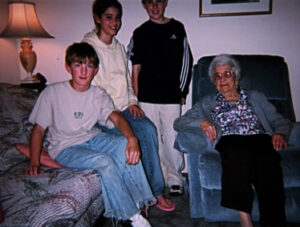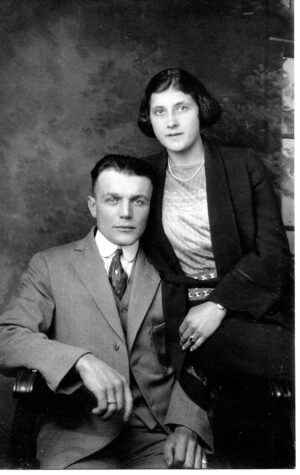We are featuring again transcribed excerpts from the oral history project that was created 20 years ago by the students of Ryan Olson Day’s Options Class at the Mendocino Middle School. With the help of Steven Jordan and a grant obtained by Deena Zarlin, they made audio recordings of their interviews with 12 “Old Timers,” who told these children what it was like living here on the Coast in the first part of the 20th century.

Kept all this time in the Kelley House Museum’s archival vault, we are publishing these stories now for the first time.
The date is March 15, 2000, and the children are speaking with Lena Luzzi, a 95-year-old Mendocino Coast native. They are joined in the conversation by Lena’s niece, Toby Tavelli, a graduate of Mendocino High School; Lena’s great niece, Janice Sverko; and Janice’s son, Lena’s great-great nephew, Christian Sverko. The student interviewers are Cody Reber and Sadie Pepper, with Will Tomlinson as the technical recorder.
The conversation begins with Lena telling the children about the immigration journey her parents made to the West Coast from Punano, Italy. A 16-day boat passage got them to New York, first her father in 1902, then her mother in 1903. Once together again, a three-day train ride took them across the continent to San Francisco. After an overnight stay in the city, they took a passenger boat up the coast to Fort Bragg, then drove a horse and buggy to Mendocino the next day. Her father had work as a tie maker.
“So that’s where I was born,” Lena says. “I was born in 1904 at Nichols and Jarvis’ tie camp, that’s way above where the Woodlands is now. Then when I was still young, they moved to Jack Peter’s Gulch in Mendocino. Then about a year or so they moved up to Ten Mile, then back to Mendocino, and then we moved up to the Mendocino-Comptche Road. They bought a place there, a 40-acre ranch, and we lived there on that place until 1919 when we moved to Albion. And there I lived in Albion until I really moved from Albion in 1974.”

The children want to know how she got to school. Lena replies that when they lived on the Mendocino-Comptche Road, school was a good three miles each way into town. “Oh, we went, we walked, now, we had to go across the old Mendocino bridge, and there it was really low over the river. It used to be kind-of flat, and then on the end towards Mendocino used to be kind of a slant and on high tide the water used to be right at the foot of the bridge. And on that flat at that time there was the big lumber mill and there were all kinds of cabins there. You know and a cookhouse and then we had to go across that flat and where we had to walk there was a big sidewalk. And we had to go up an incline and we had to come across the highway and then we took that road [Evergreen Street] that took us to the school. If you can remember that, if you are in Mendocino, that big house, that used to be Ed Boyles’ house [now Pamela Hudson Realty] and we used to go along that sidewalk and then there was another house. There were three houses and then we came up to the schoolhouse fence. There they had taken three pickets out and we used to go through that hole, then walk across the schoolyard. We barely made it there when the third bell rang.”
Sadie asks about her life at the Albion Hotel, now gone, which her family ran for a number of years. Lena replies that they had 22 or 23 boarders at that time. “We served three meals a day, morning, lunch and evening. And in the morning, breakfast was to order, they would order whatever the wanted to. But the noon meal and the evening meal it was just family style with big platters on the table.”
Cody is curious about her husband, Bob, to whom she was married for almost 35 years when he passed away. Lena explains that during the Depression, when there wasn’t much work, she usually went out with him when he made split ties. “I’d make posts and grape stakes out of the tie slabs. And I hewed those posts. I had a little broad axe and I hewed the posts on four sides for 3 cents apiece, for a seven-foot post.”
During this interview, the children are treated to Lena’s remarkable recollection of what Mendocino’s Main Street looked like with its stores and its residents. She tells them of the annual Pomo Indian migration to the coast, of gypsies that terrorized local children, the perils of mushroom collecting, sustaining themselves with hunting and gardening during the Great Depression, and the tidal wave that almost took her out to sea while gathering abalone. Tales well worth remembering!
The transcript and audio recording of Lena’s stories, as well as those from the other “Old Timers,” are available to the public at the Kelley House Museum. For details, email Director-Curator Karen McGrath at curator@kelleyhousemusem.org.
While the Museum is temporarily closed, be sure to check out our newest digital exhibit, “South of Main,” available at no cost on our website www.kelleyhousemuseum.org.